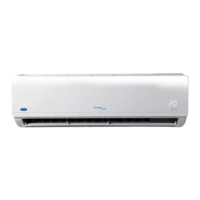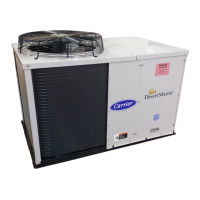19
Low Ambient Operation
Low ambient operation will be used when either of the 2
conditions is met: 1) OAT is less than low ambient temperature
(LOW AMBIENT TEMP) –5_F or 2) OAT is less than low
ambient temperature (LOW AMBIENT TEMP) –2.5_Fandthe
Saturated Discharge Temperature (CIR.A DIS. TEMP) is less than
92_F. The low ambient ODF control will manipulate ODF speed to
keep the discharge temp above 95_F. As OAT continues to drop,
ODF speed will continue to decrease, at certain point, the low
ambient control may decide to turn off ODFs and only control the
speed of the rest of the outdoor fans. If the discharge temp keeps on
decreasing, it may reach a point that all ODF fans will be turned
off. The ODFs will be turned on starting from the highest number
first, meaning the ODF1 will be the last one to shut off. The ODFs
are protected with a 45 second run time and a 60 second off time.
See Fig. 12 for the ODF arrangement. The lowest speed allowed to
run any ODF is determined by the outdoor fan Minimum Speed
Configuration (ODF MINIMUM SPEED).
NOTE: During ODF cycling all fans that are commanded on will
be at the same speed and the ones off will be at zero speed. The
motors will not be allowed to run different speeds at the same time.
Whe n OAT r ises above low ambi ent tempera t ure (LOW AMBIENT
TEMP), ODF control will transition from low ambient to normal
operation. A period (5 min) is allowed for the ODF speed to ramp
from current position to one of the 4 discrete speed settings.
IMPORTANT: The low ambient temperature (LOW AMBIENT
TEMP) is default to 66 degrees and should not be changed unless
directed by authorized Carrier Personnel.
Optional Humidi--MiZer
R
De humidif ic ation System
Units with the factory--installed Humidi--MiZer system option are
capable of providing multiple modes of improved
dehumidification as a variation of the normal cooling cycle. The
Humidi--MiZer system option includes additional valves in the
liquid line and discharge line of each refrigerant circuit, a reheat
coil downs tr eam of the eva porator, and variable--speed c ontrol of al l
the outdoor fa ns. The Humidi--MiZe r sys tem equi pped c onf iguration
is factory se t to Yes for Humidi--MiZe r system equipped unit s
(HUMIDIMIZER OK = YES). This enables Humidi--MiZer system
operating modes and service test.
Humi di--MiZe r s ystem operation re quires the i nstal lation a nd
configuration of a relative humidity swi t ch i nput or a space re l ative
humidity sensor. The HUMI DISTAT a nd SPRH leads are provided
with quic k conne cts. The Spac e Humidi t y Swit ch conf iguration,
SETTINGS UNIT CONFIGURATIONS SWITCH INPUTS
CONFIGS HUMSTA T CHANNEL identifies the normally open
or norma l ly closed s tatus of thi s input at high humidity. The Spa ce
RH Se nsor c onfiguration, SETTINGS UNI T
CONFIGURATIONS ANALOG INPUTS CONFIGS SPRH
SENS CHANNEL, ident ifies to the channel number the s ensor is
wired int o.
Dehumidification Demand
Whe n usi ng a humidi sta t or s witch input, the demand for
dehumidification is seen as Space Humidity Switch
(I NPUTSSWITCH INPUTSHUMIDI STA T) being Low or
High. A l ow value me ans humidity level is good and a high value
means that dehumidification is needed.
When using an SPRH sensor, the demand is based on the Space
Humi di ty Sensor (I NPUTSANALOG INPUTSSPRH) value
compared to the Space RH Setpoint (SETTI NGSSPACE
SETPOINTSSPRH SETPOINT). If the Space Humi di ty Sens or
(SPRH) val ue is above the Spac e RH Set poi nt ( SPRH Set poi nt), then
dehum i dific ation is nee ded. If the Spa ce Humidi ty Sensor (SPRH)
value is below the Space RH Setpoint (SPRH Set point) mi nus t he
Space RH Deadband (SETTINGSUNIT CONFIGURATIONS
COOLINGSPRH DEADBAND), then dehumidification is no
longer needed.
NOTE: When there is a dehumidification demand, the economizer
damper position is limited to its minimum damper position.
Humidi--Mi Zer System Modes
With Humidi--MiZer system units there are two additional HVAC
modes available for the user: Dehumidification and Dehum/Mech
Cooling. Selection of the Dehum/Mech Cooling mode is
determined by the dehumidification demand and the cooling
demand. Table 11 shows the corresponding circuit mode and
output status for the different demand combinations.
Normal Cooling
For 48/50LC07-- 26 units, refrigerant flows from the outdoor
condenser through the de-- energized 3--Way Liquid Diverter Valve
(LDV) to the expansion device bypassing the reheat condenser
coil. The Reheat Discharge Valve (RDV) is closed. (See Fig. 14.)
Tabl e 11 – Humidi--Mi Zer Syst em Control Modes -- Sizes 07--26
DEMAND AND MODE OUTPUTS 48/50LC 07--- 26 Valves
Space
Humidity
Circuit
Cooling
Demand
Circuit
Mode
Circuit
Compressor
LDV Valve
3 --- w a y
RDV Valve
2 --- w a y
— – No power Off Off
Off
(closed)
Low No Off Off Off
Off
(closed)
Low Yes Cool On Off
Off
(closed)
High Yes
Dehum/Mech
Cooli n g
On On
Off
(closed)
High No Dehum On On
On
(open)
For 48/50LC04-- 06 units, refrigerant flows from the outdoor
condenser and is diverted at the energized Reheat Liquid Valve
(RLV) and flows through the de--energized Cooling Liquid Valve
(CLV) to the expansion device bypassing the reheat condenser coil.
The RDV is closed.
Table 12 – Humi di--MiZe r Syst em Control Mode s -- Siz es 04--06
DEMAND AND MODE OUTPUTS 48/50LC 04---06 Valves
Space
Humidity
Circuit
Cooling
Dema n d
Circuit
Mode
Circuit
Co mpre sso r
RDL
Valve
RL V
Valve
CL V
Valve
— –
No
power
Off
Off
(closed)
Off
(open)
Off
(open)
Low No Off Off
Off
(closed)
Off
(open)
Off
(open)
Low Yes C ool On
Off
(closed)
Off
(closed)
Off
(open)
High Yes
Dehum/
Mech
Cooli n g
On
Off
(closed)
Off
(open)
On
(closed)
High No Dehum On
On
(open)
Off
(open)
On
(closed)
Dehum/Mech Cooling (Subcooling Mode)
This mode increases latent heat removal and decreases sensible
cooling compared to normal cooling. For 48/50LC07--26 units,
refrigerant flows from the outdoor condenser, through the
energized 3-- Way Liquid Diverter Valve (LDV) and through the
reheat condenser coil to the expansion device. The Reheat
Discharge Valve (RDV) is closed. (See Fig. 16.)
For 48/50LC04-- 06 units, refrigerant flows from the outdoor
condenser through the de--energized Reheat Liquid Valve (RLV)
and through the reheat condenser coil to the expansion device. The
Reheat Discharge Valve (RDV) and Cooling Liquid (CLV) are
closed. (See Fig. 15.)

